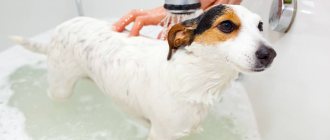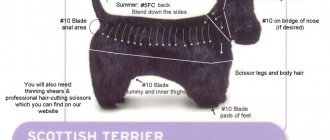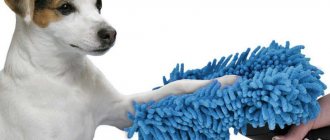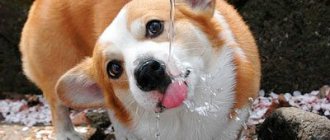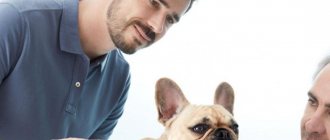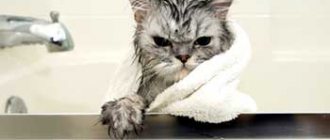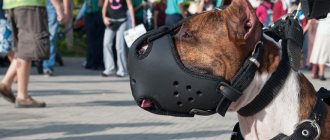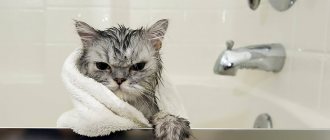When should you wash your dog?
You can’t bathe your pet every day just because the owner has a lot of different care products and wants to try them out.
Water treatments can harm your pet, so they are used:
- in hot weather;
- with visible contamination;
- if there is a dog smell;
- if there are wounds or bites.
Often this is not necessary.
In the heat
In hot weather, it is necessary to wash your four-legged friend. This is especially true when the dog is lying on the ground and, entering the apartment, begins to wipe himself on clean furniture. Water helps the animal cope with the heat.
It should be remembered that the pet is bathed at room temperature, and drying should be natural. It is important to ensure that the room where the dog is drying does not have air conditioning and there are no drafts.
It is prohibited to pour cold water on an animal in the heat - this is severe stress for the body.
For visible dirt
People use a washcloth when taking a shower to remove dead skin and dirt.
Animals need this too. You can’t just wash a dirty dog, it must be done. It is not difficult to notice dirt: the fur becomes dull, lumps of dirt hang in some places, and an unpleasant odor emanates from the pet.
When the house smells like dog
Even an indoor dog should be washed. If there is no visible contamination, you should focus on the smell.
The animal's skin secretes a special fat, reminiscent of a goose's, which protects the four-legged animal from the cold. As it accumulates, it begins to smell unpleasant. This is a signal to swim.
In case of wounds and bites
Having noticed that cuts or other injuries have appeared on the animal’s body, the first step is to wash the dog, clearing the fur and skin of dirt.
Then they act according to the situation.
Answer to the question “how often to wash your dog”:
- Does the dog live in an apartment or on the street?
Does she sleep in your bed? If your pet lives with you in the house, moreover, if he sleeps in your bed, then most likely you will wash him quite often; of course, everything will also depend on the breed of the animal. As a rule, the regularity of water procedures can range from once a week to once a month. Some are sure that such frequent bathing is not entirely beneficial for a four-legged friend. But if the dog is sitting on the couch or on your bed, then you probably don't want him to get them dirty. This is the whole conclusion. The fur may be a little drier, but the animal will be clean and smell nice, and it will be a pleasure to stroke it! - What breed is your dog?
A dog's hard fur repels various types of dirt much better than soft hair. Dogs with a hard coat, such as a Sheltie, can be bathed once a month, but those with a soft coat, such as a Yorkie, will need to be bathed once a week. Don’t forget that a clean dog always feels happy! - Does anyone in your family have a dog allergy?
If among your family members there are those who suffer from allergies to dogs, then you need to bathe the animal more often.
According to the results of American studies, regular washing of the dog
allows you to remove dandruff, which accumulates abundantly on the animal’s fur. Most people who are allergic to dogs and rarely wash their dogs have various allergic complications. - How does your dog spend his time?
Are you walking your pet in the park?
Do you allow your animal to play in the sand, or maybe your dog likes to run through puddles, roll around in the grass, or just loves to roll around in the dust? If your dog is developing normally, then most likely he does at least one of the above actions, and quite often! This means that you need to wash your dog often
! Its fur will be a little drier, but it will be clean and smelling, and it’s much more pleasant to caress a clean animal than a dog with dirty, oily fur. - Does your pet suffer from itchy skin?
Unlike humans, who are able to absorb most allergens in the environment through their nose and mouth, dogs do this through their skin. In other words, it is the dog’s skin that absorbs all allergens! Weekly bathing will effectively and promptly remove all allergens before they enter the animal's body through the skin.
Selecting a detergent
Shampoo for animals must be chosen carefully.
Can the products be used on people?
Shampoos that are intended for owners are not suitable for pets: they contain strong fragrances that irritate the dog’s sense of smell, and toxic substances that can harm the animal.
Products for different breeds and coat types
Pet stores offer a variety of dog shampoos.
It is important to ensure that the product contains egg yolk, lecithin or lanolin. These components allow the coat to shine, look beautiful, and protect the dermis from the negative effects of external factors. Products are chosen depending on the type of coat and the pet’s reaction to cosmetics. If you have an allergy, do not use untested cosmetics.
To avoid trouble, you need to consult a veterinarian.
Proved themselves perfectly:
- Espree Coat Renewal Texturizing. The shampoo is ideal for animals with curly and coarse hair. Recommended for terriers. Other breeds are no exception.
- BIO-Groom protein/lanolin. The product copes well with dirt, cleanses the coat, giving it a flawless appearance. The composition includes coconut oil, making cosmetics “softer” and care more gentle.
Mr.Bruno is a shampoo-conditioner for babies. Designed for puppies and weakened animals. After it, the fur becomes soft and easy to comb.- 8in1 Tea Tree oil Shampoo. Suitable for dogs of all ages. It is a bestseller due to its low cost and high quality.
There are other options on sale. Some manufacturers develop breed-specific detergents to make the coat easier to care for.
Dry shampoos: when to use
Dry shampoos resemble powder, evenly distributed over the surface of the coat. Special granules absorb dirt and grease.
To use, you do not need water, just apply the product, comb the wool thoroughly, removing excess powder.
The product should not be used frequently because it dries out the skin. The shampoo is ideal for weakened animals, older dogs and babies.
How often are dogs washed?
Usually they are washed 1-2 times a month, depending on the time of year. For most pets, this rule works effectively, since the layer of sebum is not completely washed off, but lost along with impurities, it has time to be restored. In summer, metabolic processes are more active, the possibility of getting dirty is much higher, so you need to bathe a little more often (usually 2 times a month).
There are also force majeure events. Your four-legged pet may not resist the temptation to roll in the sand or, worse, fall. It is more than clear what “aroma” he will bring into the house. Therefore, the owners take forced and effective measures. If an unscheduled wash occurs, you should take it into account when performing the following, so that sebum has time to form in sufficient quantities.
Please note that you need to be very careful when bathing a pregnant dog. Many breeders avoid this if possible if the situation allows them to do so. In addition, pregnancy is quite difficult to determine in the first two weeks, so washing continues as usual. When it becomes known that the dog is pregnant, swimming in natural bodies of water is excluded in order to avoid infection (this means the case if the loop remains open).
To avoid allergic reactions, use special shampoos that are gentle on the skin and do not contain flea and tick medications. This treatment is carried out before mating. After bathing, the expectant mother should be dried thoroughly to prevent hypothermia.
There are breeds that require more frequent washing due to their skin and coat characteristics. These include the Maltese (Maltese Bichon) with its long coat that requires careful care. A similar picture emerges with Yorkshire terriers, whose soft coat is easily soiled.
If vaccination has been carried out, then there is no need to bathe the dog after vaccination. For a week, you should avoid even getting water on the injection site. The animal’s body will be weakened for another 10 to 20 days, since all its internal resources are aimed at developing immunity. During this period, it is better to take care of your pet.
Long and soft coat requires careful grooming
Preparing your pet for a bath
Despite the fact that the dog is short-haired or, conversely, has long hair, it is prepared for the procedure. Before bathing, the pet is examined and combed.
Inspection
This stage is important because it allows you to avoid unpleasant sensations. If deep wounds or scratches are found on your pet’s body, it is better to postpone bathing and contact a veterinarian.
Areas of small cuts should be washed with water without applying detergents.
Combing
To prevent the fur from getting tangled, it should be combed.
This is especially true for long-haired pets. You need to take a soft brush and start combing carefully according to the hair growth. When the wool gives in easily, the procedure can be completed.
Preparing for the bathing procedure
Before washing, long-haired dogs are combed well to get rid of dead hairs and tangles. This will make bathing easier and save you from cleaning the drain.
Before you begin the bathing procedure, you need to choose a suitable place. If you live in a private house, you can wash your dog in the yard, basin or pool. In other cases, a bath or shower will do. A small dog will easily fit in a sink or bowl.
Your dog's paws may slip in the bathtub, so place a towel or rubber mat on the bottom. You also need to lay something non-slip on the floor so that when the animal jumps out of the bathtub, it won’t slip and break its legs.
Drafts are not allowed. An hour and a half before the procedure, close the windows and doors, turn off the air conditioners. In winter, it is better to warm up the room using a radiator.
Large dogs are bathed with a collar. It will be possible to hold the animal by it in case of resistance. Close the bathroom door to prevent the dog from running away.
Prepare everything you need at once: warm water (no more than 37-40 0 C), shampoo, towel, close the dog’s ear canals with cotton swabs. If your dog doesn’t like water and tries to bite you while bathing, put a muzzle on it.
Algorithm for bathing a four-legged friend
You need to bathe your dog correctly. In this case, the animal will feel comfortable and free, without fear of water and foam.
Bathing
First, thoroughly wet the animal's fur.
It is necessary to ensure that water does not flow over the face or get into the ears. The same applies to soap. At the same time, you need to lather the fur, making sure that your movements are smooth: they should not be sharp, scaring the dog. The fur is massaged for several minutes to make it easier to remove dirt.
Rinse
The soap should be washed off gradually, starting from the neck and ending with the tail.
The paws come last. After making sure that there are no traces of shampoo, you need to wrap your pet in a towel that absorbs water well.
Drying
It is necessary to exclude drafts, open windows, turned on fans and air conditioners.
You should not use a hairdryer: overdried skin will begin to itch and dandruff will appear.
Drying should occur naturally. The exception is long-haired animals: they can be slightly dried.
Combing
Four-legged animals with short hair can be left alone: it does not stick together or get tangled, which cannot be said about long-haired breeds.
Such dogs need to be combed after bathing.
How to properly wash a dog?
It is important that bathing does not harm your four-legged pet. To do this, you should follow some rules. The methods for washing a puppy and an adult dog are not fundamentally different. You need to bathe your dog after a walk, not before it. This way you can avoid problems - a walked dog will have enough time to dry, because different breeds have different coats that take different times to dry - from half an hour to several hours. It is important not to let your pet outside until the undercoat is completely dry, otherwise he runs the risk of catching a cold or even pneumonia, especially in winter and late autumn. If you do not visit a grooming salon, but wash your dog in the bath at home, you should follow this sequence of actions:
- You need to pour water into the bath so that it barely reaches the animal’s stomach. When the puppy is first bathed, it should be even less so as not to scare the baby. The water temperature should not exceed 37°C.
- Before placing an animal in water, it is advisable to plug its ears with cotton swabs to protect them from water. You should know that when washing, water should not get into the eyes and nose of the animal, so the head is washed sparingly, without watering it from the shower.
- After placing the dog in the bath, you need to start washing by completely wetting the fur. First, water the back, neck, then the tail and paws.
- The shampoo must be pre-diluted in a separate container, as it usually has a high concentration (3:1, 5:1).
- First, lather the back, and then the neck, head and tail, paying attention to the area under the tail. If you plan to cleanse the paraanal glands, it is better to do this before swimming.
- After a good lathering with shampoo, the dog is showered and, if necessary, coat balm or conditioner is applied.
- After washing off the balm with cool water and draining the water, the wool is wrung out by hand and then thoroughly blotted with a terry towel.
- After drying, dry it with a hairdryer. A long-haired pet should not be allowed to run around the apartment so that the fur dries on its own, as it will get tangled. When treating strands with a hairdryer, they should be combed at the same time.
If the dog is afraid of water
Not all animals love to swim. It is believed that you can’t drag a pooch into the bathroom, but this is not true. Sometimes even small dogs refuse water procedures.
Is it worth wearing a muzzle?
Some owners believe that a muzzle is the ideal solution to prevent their pet from biting. It's the other way around. A dog that is afraid, realizing that it is being muzzled, will not allow itself to be dragged into the bathroom next time.
She will fall and squirm, but will not allow herself to be washed. Everything must be done carefully. You should calm the animal down and give it a treat. Soaping must be done quickly but carefully; rinsing is recommended gradually but intensively.
Encouragement and praise tactics
To make the dog less nervous, you can give the animal a favorite treat, showing that the four-legged dog deserves it for its efforts to keep up.
Providing the dog with a sense of security
Water procedures are carried out only in an environment familiar to the dog, so that it does not worry. If the animal is nervous, it is recommended to pet it. Don't scream or lose your temper when something goes wrong.
